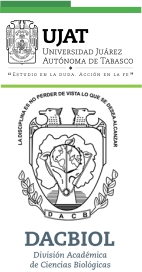LAS NITRORREDUCTASAS Y SU APLICACIÓN EN BIOTECNOLOGÍA
DOI:
https://doi.org/10.19136/kuxulkab.a17n32.382Resumen
Las nitrorreductasas (NR) son un grupo de enzimas ampliamente distribuidas en bacterias, archaea y algunos organismos eucariotas. Son flavoproteínas dependientes de NAD(P)H, que es utilizado como donador fisiológico de electrones para la reducción del grupo nitro presente en una gran variedad de sustratos, produciendo los derivados hidroxilamino o amino correspondientes, así como también para la reducción de quinonas y flavinas. El cofactor flavínico de las nitrorreductasas es el FMN. La actividad nitrorreductasa también se asocia a una diversidad de enzimas, incluyendo la xantina oxidasa, la aldehído oxidasa, varias flavoproteínas, la NADPH–citocromo P450 reductasa y el citocromo P450. Las isoenzimas principales del citocromo P450 (CYP) que exhiben actividad nitrorreductasa son las isoenzimas CYP1A2, CYP3A4 y CYP2B10.Descargas
Referencias
Abayomi O. 2007. Molecular strategies of microbial adaptation to xenobiotics in natural environment. Biotech. Mol. Biol. Rev., 2: 1–13
Aiub C.A., Mazzei J.L., Pinto L.F., Felzenszwalb I. 2006. Evaluation of nitroreductase and acetyltransferase participation in N–nitrosodiethylamine genotoxicity. Chem.-Biol. Interact., 161: 146-154
Anuseviĉius Z, Martínez-Julvez M, Genzor DG, Nivinskas H, Gómez-Moreno C, Ĉènas N. 1997. Electron transfer reactions of Anabaena PCC7119 ferredoxin NADP+ reductase with nonphysiological oxidants. Biochim. Biophys. Acta, 1320: 247-255
Asnis R.E. 1957. The reduction of furacin by cell-free extracts of furacinresistant and parent–susceptible strains of Escherichia coli. Arch. Biochem. Biophys., 66: 208-216
Beland F.A., Kadlubar F.F. 1990. Metabolic activation and DNA adducts of aromatic amines and nitroaromatic hydrocarbons. In: Cooper CS, Grover PL (eds.), Chemical Carcinogenesis and Mutagenesis. Springer–Verlag, Berlin, pp 267–325.
Bironaitè DA, Ĉènas N, Kulys JJ. 1991. The rotenone–insensitive reduction of quinones and nitrocompounds by mitochondrial NADH: ubiquinone reductase. Biochim. Biophys. Acta, 1060: 203-209
Black J.G. 1999. Bioremediation. In: Microbiology: Principles and Explorations, 4th edition, Prentice Hall Publishers, Upper Saddle River, pp 751–752.
Bryant C.H., DeLuca M. 1991. Purification and characterization of an oxygen–insensitive NAD(P)H nitroreductase from Enterobacter cloacae. J. Biol. Chem., 266: 4119–4125
Bryant D.W., McCalla M., Leelsma M., Laneuville P. 1981. Type I nitroreductases of Escherichia coli. Can. J. Microbiol., 27: 81–86
Choi J.W., Lee J., Nishi K., Kim Y.S., Jung C.H., Kim J.S. 2008. Crystal structure of a minimal nitroreductase, ydjA, from “Escherichia coli” K12 with and without FMN cofactor. J. Mol. Biol., 377: 258–267
Denny W.A. 2002. Nitroreductase–based GDEPT. Curr. Pharm. Des., 8: 1349–1361
Fouts J.R., Brodie B.B. 1957. The enzymatic reduction of chloramphenicol p–nitrobenzoic acid and the other aromatic nitro–compounds in mammals. J. Pharmacol. Exp. Ther., 119: 197–207
Gerrits M.M., van der Wouden E.J., Bax D.A., van Zwet A.A., van Vliet A.H.M., de Jong A., Kusters J.G., Thijs J.C., Kuipers E.J. 2004. Role of the rdxA and frxA genes in oxygen–dependent metronidazole resistance of Helicobacter pylori. J. Med. Microbiol., 53: 1123–1128.
Gómez R. 2009. Degradación de compuestos nitroaromáticos por Rhodobacter: Purificación de la nitrorreductasa NprB. Tesis Doctoral. Universidad de Córdoba. España.
Holtzman J.L., Crankshaw D.L., Peterson F.J., Polnaszek C.F. 1981. The kinetics of the aerobic reduction on nitrofurantoin by NADPH–cytochrome P–450 reductase. Mol. Pharmacol., 20: 669–673
Horie S., Watanabe T., Ohta A. 1982. Studies on the enzymatic reduction of C–nitroso compounds. V. Molecular proper t ies of porcine hear t C–nitrosoreductase and identity of this enzyme with NAD(P) H dehydrogenase. J. Biochem., 92: 661–71
Kadiyala V., Nadeau L.J., Spain J.C. 2003. Construction of Escherichia coli strains for conversion of nitroacetophenones to ortho–aminophenols. Appl. Environ. Microbiol., 69: 6520–6526
Kim H.Y., Song H.G. 2005. Purification and characterization of NAD(P)H–dependent nitroreductase I from Klebsiella sp. C1 and enzymatic transformation of 2,4,6–trinitrotoluene. Appl. Microbiol. Biotech., 68: 766–773
Knox R.J., Connors T.A. 1997. Prodrugs in cancer chemotherapy. Pathol. Oncol. Res., 3: 309–324
Knox R.J., Friedlos F., Boland M.P. 1993. The bioactivation of CB1954 and its use in antibody–directed enzyme prodrug therapy (ADEPT). Cancer Metast. Rev., 12: 195–212
Knox R.J., Burke P.J., Chen S., Kerr D.J. 2003. CB1954: from the Walker tumor to NQO2 and VDEPT. Curr. Pharm. Des., 9: 2091–2104
Koder R.L., Miller A.F. 1998. Steady–state kinetic mechanism, stereospecificity, substrate and inhibitor specificity of Enterobacter cloacae ni t roreductase. Biochim. Biophys. Acta, 1387: 395–405
Koder R.L., Haynes C.A., Rodgers M.E., Rodgers D.W., Miller A.F. 2002. Flavin thermodynamics explain the oxygen insensitivity of enteric nitroreductases. Biochemistry, 41: 14197–14205
Kutcher W., McCalla D. 1984. Aerobic reduction of 5–nitro–2–furaldehyde semicarbazone by rat liver xanthine dehydrogenase. Biochem. Pharmacol., 33: 799–805
Lewis T.A., Newcombe D.A., Crawford R.L. 2004. Bioremediation of soils contaminated with explosives. J. Environ. Manag., 70: 291–307
Marques de Oliveira I, Pêgas J.A., Bonatto D. 2007. In silico dentification of a new group of specific bacterial and fungal nitroreductase–like proteins. Biochem. Biophys. Res. Commu., 355: 919–925
Mason R.P., Holtzman J.L. 1975a. The role of catalytic superoxide formation in the O2 inhibition of nitroreductase. Biochem. Biophys. Res. Commun., 67: 1267–1274
Mason R.P., Holtzman J.L. 1975b. The mechanism of microsomal and mitochondrial nitroreductase. Electron spin resonance evidence for nitroaromatic free radical intermediates. Biochemistry, 14: 1626–1632
McCalla D.R., Reuvers A., Kaiser C. 1971. Activation of nitrofurazone in animal tissues. Biochem. Pharmacol. 20: 3532–3537.
Miskiniene V., Šarlauskas J., Jacquot J., Čėnas N. 1998. Nitroreductase reactions of Arabidopsis thaliana thioredoxin reductase. Biochim. Biophys. Acta, 1366: 275–283
Moreno S., Mason R., Docampo R. 1984. Reduction of nifurtimox and nitrofurantoin to free radical metabolites by rat liver mitochondria. J. Biol. Chem., 259: 6298–6305
Nishino S.F., Spain J.C. 1993. Degradation of nitrobenzene by a Pseudomonas pseudoalcaligenes. Appl. Environ. Microbiol., 59: 2520–2525
Nokhbeh M.R., Boroumandi S., Pokorny N., Koziarz P., Paterson E.S., Lambert I.B. 2002. Identification and characterization of SnrA, an inducible oxygen–insensitive nitroreductase in Salmonella enterica serovar Typhimurium TA1535. Mut. Res., 508: 59–70
Orna V.M., Mason R.P. 1989. Correlation of kinetic parameters of nitroreductase enzymes with redox properties of nitroaromatic compounds. J. Biol. Chem., 264: 12379–12384
Padda R.S., Wang. C., Hughes J.B., Bennett G.N. 2003. Mutagenicity of nitroaromatic explosives during anaerobic transformation by Clostridium acetobutyl icum. Environ. Toxicol . Chem., 22: 2293–2297
Rafii F., Franklin W., Heflich R.H., Cerniglia C.E. 1991. Reduction of nitroaromatic compounds by anaerobic bacteria isolated from the human gastrointestinal tract. Appl. Environ. Microbiol., 57: 962–968
Ramos J.L., González-Pérez M.M., Caballero A., van Dillewijn P. 2005. Bioremediation of polynitrated aromatic compounds: plants and microbes put up a fight. Curr. Opin. Biotech., 16: 275–281
Rieger P.G., Knackmuss H.J. 1995. Basic knowledge and perspectives on biodegradation of 2,4,6–trinitrotoluene and related nitroaromatic compounds in contaminated soil. In: Spain JC (ed.), Biodegradation of Nitroaromatic Compounds. Plenum Press, New York, pp 1–18.
Rieger P.G., Meier H.M., Gerle M., Vogt U., Groth T., Knackmuss H.J. 2002. Xenobiotics in the environment: present and future strategies to obviate the problem of biological persistence. J. Biotech., 94: 101–123.
Riley R.J., Workman P. 1992. DT–diaphorase in cancer chemotherapy. Biochem. Pharmacol., 43: 1657–1669
Roldán M.D., Pérez–Reinado E., Castillo F. Moreno–Vivián C. 2008. Reduct ion of polynitroaromatic compounds: the bacterial nitroreductases. FEMS Microbiol. Rev., 32: 474–500
Rooseboom M., Commandeur J.N.M., Vermeulen N.P.E. 2004. Enzyme–catalyzed activation of anticancer prodrugs. Pharmacol. Rev., 56: 53–102
Šarlauskas J., Nemeikai tė–Čėnienė A., Anusevičius Ž., Misevičienė L., Marozienė A., Markevičius A., Narimantas Čėnas. 2004. Enzymatic redox properties of novel nitrotriazole explosives implications for their toxicity. Z. Naturforsch, 59: 399–404
Searle P.F., Chen M.J., Hu L., Race P.R., Lovering A.L., Grove J.I., Guise C., Jaberipour M., James N.D., Mautner V., Young L.S., Kerr D.J., Mountain A., White S.A., Hyde E.I. 2004. Nitroreductase: a prodrug–activating enzyme for cancer gene therapy. Clin. Experimen. Pharmacol. Physiol., 31: 811–816
Smyth G., Orsi B. 1989. Nitroreductase activity of NADH dehydrogenase of the respiratory redox chain. Biochem. J., 257: 859–863
Spain J.C. 1995a. Biodegradation of nitroaromatic compounds. Annu. Rev. Microbiol., 49: 523–555
Ueda O., Kitamura S., Ohashi K., Sugihara K., Ohta S. 2003. Xanthine oxidase–calalyzed metabolism of 2–nitrofluorene, a carcinogenic air pollutant, in rat skin. Drug Metab. Dispos., 31: 367–372
Wardman P., Clarke E.D. 1976. Oxygen inhibition of nitroreductase: electron transfer from nitro radical–anions to oxygen. Biochem. Biophys. Res. Commun., 69: 942–949.
Watanabe M., Ishidate M., Nohmi T. 1990. Nucleotide sequence of Salmonella typhimurium nitroreductase gene. Nucleic Acids Res., 18: 1059
Watanabe M., Nishino T., Takio K., Sofuni T., Nohmi T. 1998. Purification and characterization of wild–type and mutant “classical” nitroreductases of Salmonella typhimurium. J. Biol. Chem., 273: 23922–23928
Whiteway J., Koziarz P.J., Veall V., Sandhu N., Kumar P., Hoecher B., Lambert I.B. 1998. Oxygen–insensitive nitroreductases: analysis of the roles of nfsA and nfsB in development of resistance to 5–nitrofuran derivatives in Escherichia coli. J. Bacteriol., 180: 5529–5539
Xu G., McLeod H.L. 2001. Strategies for enzyme/prodrug cancer therapy. Clin. Cancer Res., 7: 3314–3324
Zbaida S. 2002. Nitroreductases and azoreductases. Enzyme systems that metabolise drugs and other xenobiotics. Curr. Toxicol. Series, 16: 555–566
Zenno S., Koike H., Kumar A.N., Jayarman R., Tanokura M., Saigo K. 1996a. Biochemical characterization of NfsA, the Escherichia coli mayor nitroreductase exhibiting a high amino acid sequence homology to Frp, a Vibrio harveyi flavin oxidoreductase. J. Bacteriol., 178:4508–4514
Zenno S., Koike H., Tanokura M., Saigo K. 1996b. Gene cloning, purification and characterization of NfsB, a minor oxygen–insensitive nitroreductase from Escherichia coli, similar in biochemical properties to FRaseI, the major flavin reductase in Vibrio fischeri. J. Biochem., 120: 736–744
Zenno S., Kobori T., Tanokura M., Saigo K. 1998a. Conversion of NfsA, the major Escherichia coli nitroreductase, to a flavin reductase with an activity similar to that of Frp, a flavin reductase in Vibrio harveyi, by a single amino acid substitution. J. Bacteriol., 180: 422–425
Descargas
Publicado
Número
Sección
Licencia
Los autores que publiquen en Kuxulkab' aceptan las siguientes condiciones como política de acceso abierto:
1. Que conservan los derechos de autor y ceden a la revista el derecho de la primera publicación, con el trabajo registrado con la licencia de atribucion de "Creative Commons", que permite a terceros utilizar lo publicado siempre que mencionen la autoría del trabajo y a la primera publicación en esta revista.
2. El autor puede realizar otros acuerdos contractuales independientes o adicionales para la distribución no exclusiva de la versión del artículo publicado en esta revista, como por ejemplo incluirlo en un repositorio institucional o publicarlo en un libro, siempre que se indique claramente que el trabajo se publicó por primera vez en esta revista.













